Small boats can slip into small places that can make snug places to spend the night. When I did my very first cruise up the Inside Passage, back in 1980, I usually camped on shore and used a clothesline-loop system (also known as an outhaul) to pull my 14′ dory skiff out to its anchor while I stayed on shore.
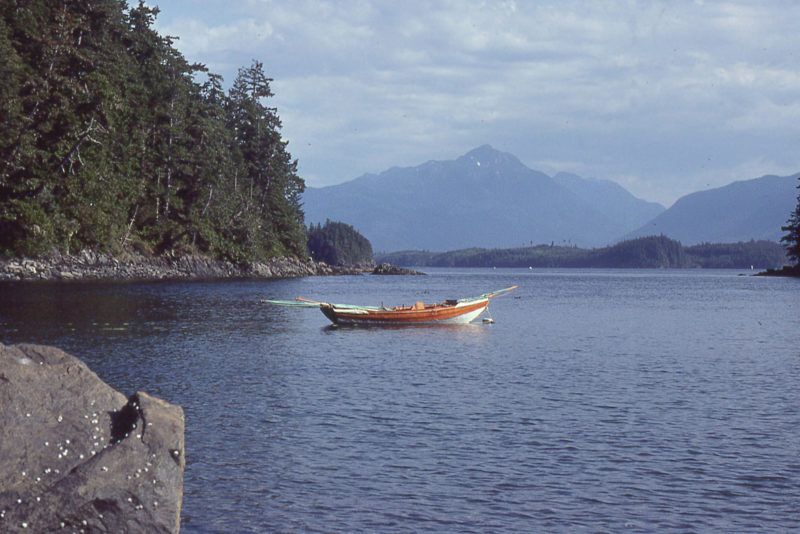 Photographs by the author
Photographs by the authorWhen I started cruising in 1980, the clothesline loop, or outhaul, was the standard anchoring method. It kept my skiff safe, but camping ashore, put me at the mercy of the mosquitoes. I began making a transition to sleeping aboard at anchor.
In more recent years, I’ve been cruising in somewhat larger boats, which I’ve built with comfortable accommodations spending the nights afloat, but it can be difficult finding anchorages that won’t dry out on a falling tide and are well protected from wind, waves, and currents. Some of the best-protected nooks and crannies in the shoreline are also the smallest and can’t accommodate an anchored boat that is free to swing about at the end of its rode.
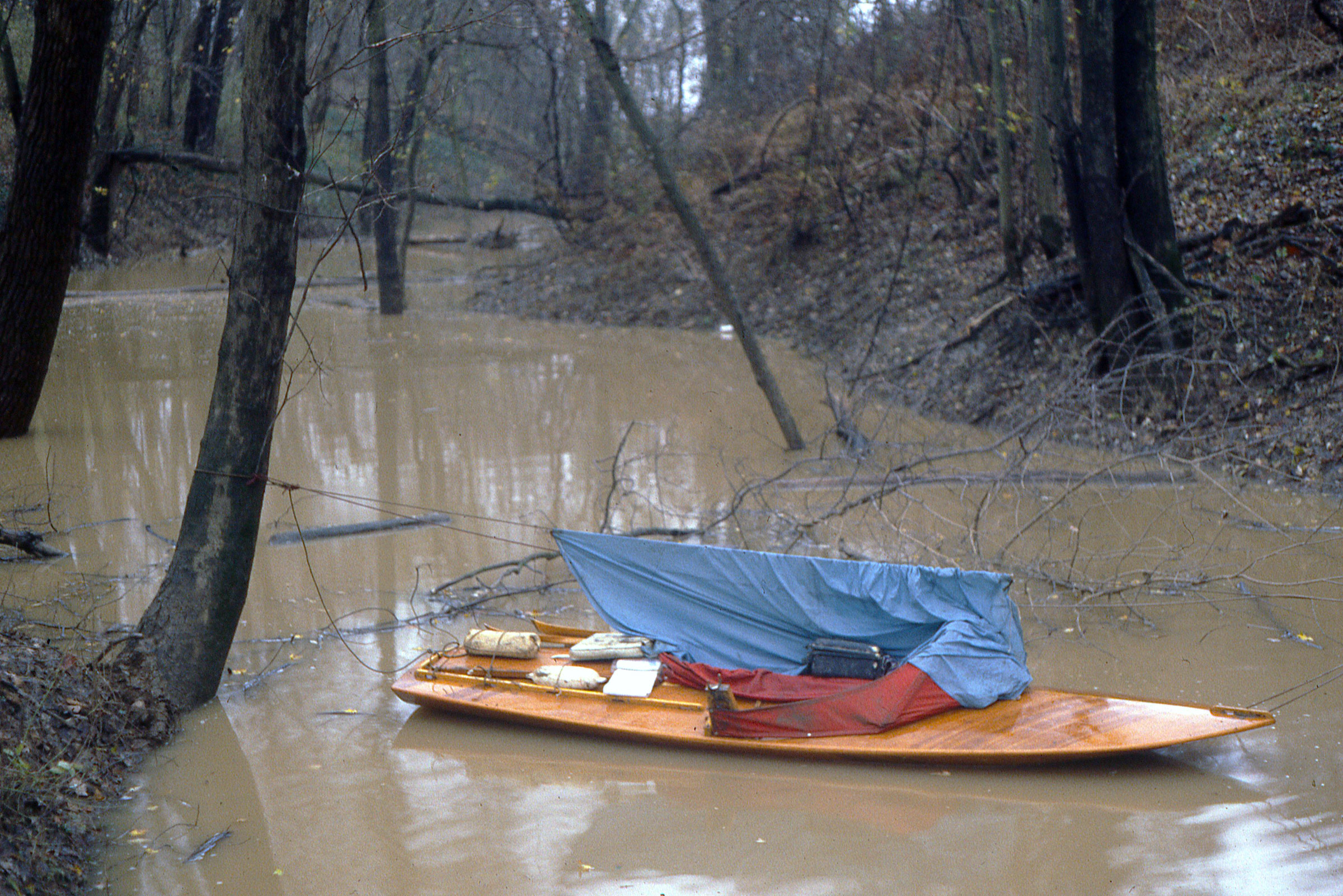
This creek that feeds into the Ohio River was my anchorage for a night. I tied the clothesline to two trees high enough above the water to use it as a ridge line for a tarp rainfly as well as for holding my sneakbox away from the banks.
On my row down the Ohio River and the second cruise up the Inside Passage, small coves were the only anchorages available in some areas. To keep the boat safe, I had to secure it at both ends so it wouldn’t stray from deep water toward shore. In these little havens, I centered the boat by tying the anchor rode from the bow to a tree on one side of the cove and a collection of other lines from the stern to the other side, leaving some slack for changing river levels or the fall of the tide.
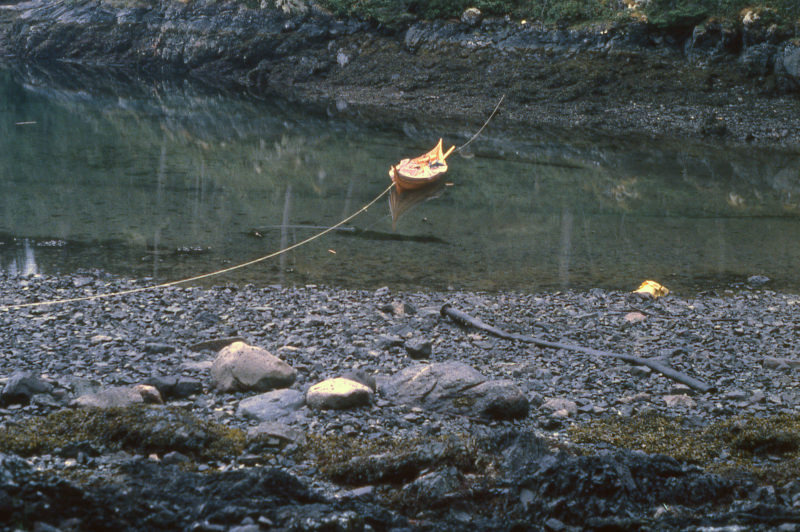
This cove was well protected from wind and waves, but not wide enough for a standard anchorage. I clotheslined the faering to keep it in the deepest water and avoid the rocks at low tide.

On this clothesline, set up for camping ashore, the boat was located over a patch of sand that would not harm the boat at low tide. Bits of wood held in clove hitches kept the lines afloat to avoid getting snagged on the bottom. The overnight high tide would rise high enough to cover the band of blackened rock. This arrangement was made possible by a cove I could walk around to tie off the ends of the lines. Here, I’m standing on the far shore.
These improvised overnight arrangements were necessitated by the absence of better anchorages, but I realized that I could sleep better with them knowing I didn’t have to rouse myself several times a night to check on the boat’s wanderings. On one occasion the boat fared well through a night, anchored in a narrow slough, but in the morning I lost my favorite anchor when I couldn’t free it from the waterlogged snags that littered the bottom. Now, I seek out the smallest coves where I can secure my boat between points on opposite banks and leave my anchor safely stowed.
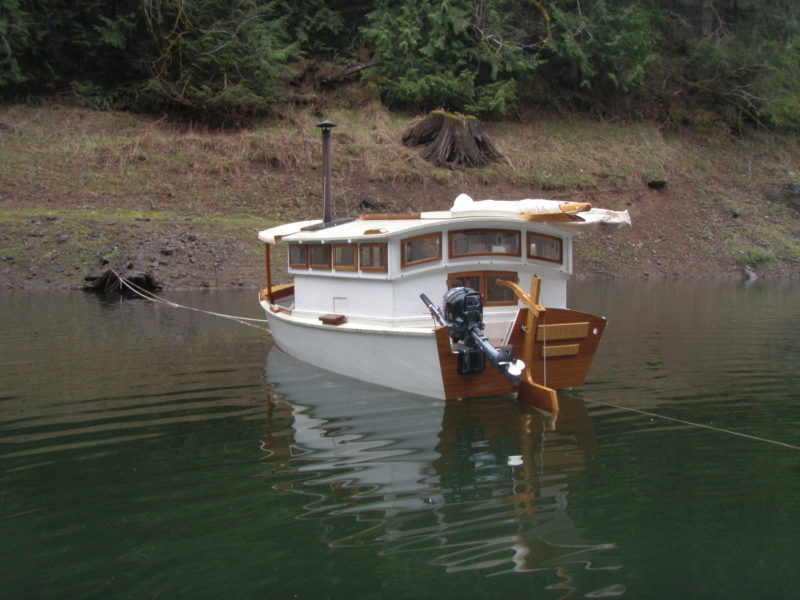
At this anchorage, I tied a bank-to-bank clothesline to stumps on either side of a creek inlet. The painter is tied in at the middle and the boat has room to swing around on that single line.
I currently use two 75′ anchor rodes to tie a “fixed clothesline” from bank to bank across the water where I’ve decided to spend the night. One of my rather hefty anchor rodes is a 1/2″ solid-braid nylon line; the other a retired 7/16″ kernmantle jibsheet from a larger boat; in the past, I’ve also used my main and jib sheets of 3/8″ twisted nylon. I paddle the boat from one side to the other, paying out the first rode. When I get to its end, I tie the second rode in with a sheet bend and continue toward shore. I try to keep the line from sinking, lest it get snagged by something underwater.
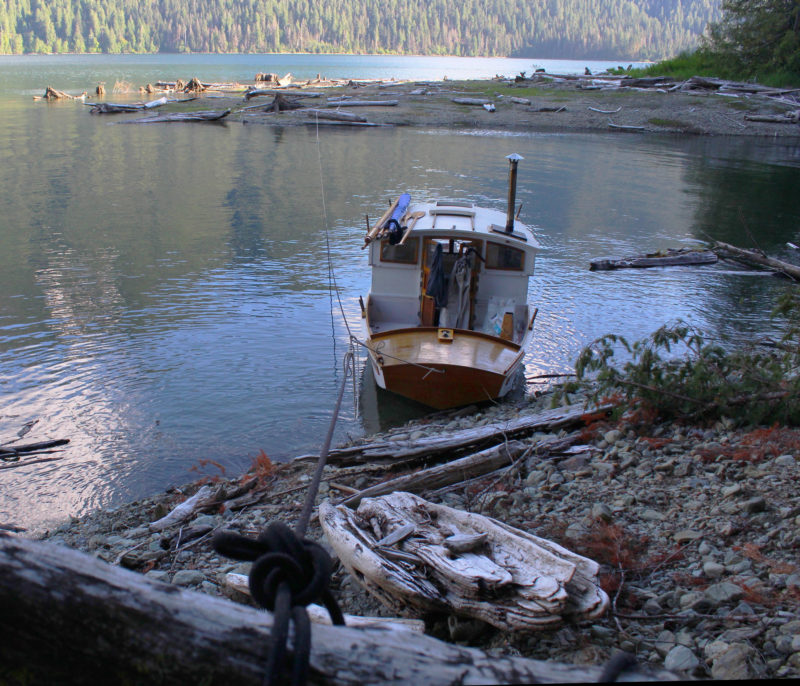
This cove was about 120′ wide and had a back eddy swirling around in it. A boat at anchor would have been carried around the cove with it, likely fouling the anchor. About 120′ of a 150′ clothesline provided a secure spot in deep water, far from the banks. Here, the boat is temporarily tied near shore while the clothesline is being made fast to an exposed tree root.
When I get to the opposite shore, I’ll tie the second rode off to something solid. If I leave the clothesline at water level with just a bit of slack, I can row or paddle across it if I want to explore a bit before settling in for the night and not be stuck on one side or the other. (A cabin, chimney, or mast can make it impossible to pass my boats under the clothesline.) Most of the time I’ll just tie the painter into the clothesline with a taut-line hitch—essentially a clove hitch with an extra turn added at the start—leaving about half of the painter (about 6′) between the bow and the hitch. That arrangement will let the boat move about on its short tether.
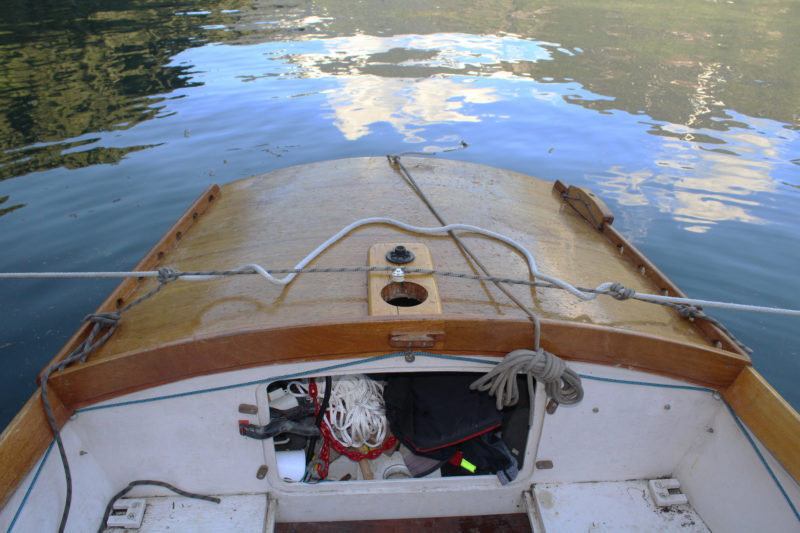
To get the bow to face the waves coming into the cove, a short grey and purple line was tied with taut-line hitches to the white clothesline. The slack pulled out of the clothesline rests on the deck. The ends of the smaller line are tied to the toerails, keeping the boat pointed into the waves.
If there are waves entering the cove, I’ll point the bow into them, trading rocking for the gentler motion of pitching so I can get a better night’s sleep. Holding the bow facing out requires tightening the clothesline; I’ll set it across the boat and tie a short line, say 4′ to 6′, into it with taut-line hitches at each end. Then I can pull the clothesline through the hitches and take up all of its slack. With the clothesline tight, I can set the boat at right angles to it and use two ties, one on each side of the boat, to hold it. Tightening the clothesline can also elevate it to keep floating driftwood from getting snagged.
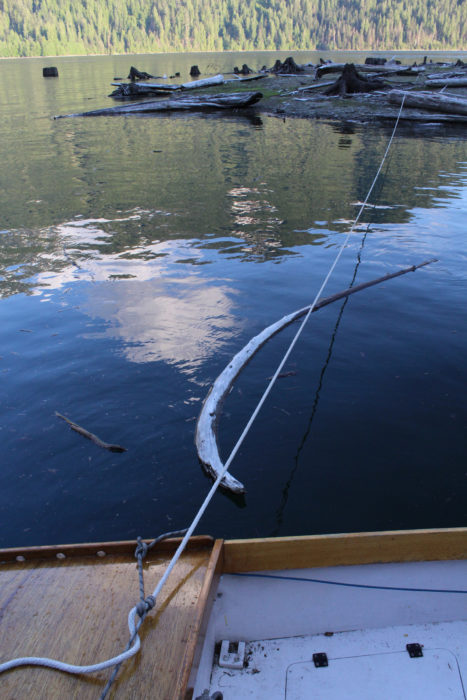
Another reason for tensioning the clothesline is to let driftwood pass under without getting snagged.
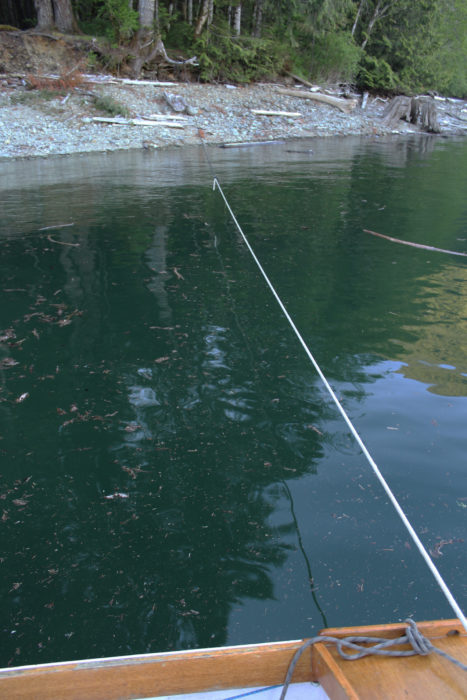
The fixed clothesline, whether it is taut and elevated or loose and submerged, makes it a barrier to other boats, so it’s appropriate to use only where it won’t be a nuisance.
When I’m spending a night at a standard anchorage, I can’t help but look up from bed to see where I am and if the boat is moving. Held in place by a fixed clothesline in a snug cove, I just sleep. ![]()
Christopher Cunningham is the editor of Small Boats Magazine.
You can share your tips and tricks of the trade with other Small Boats Magazine readers by sending us an email.
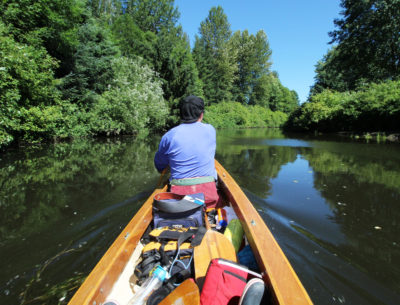

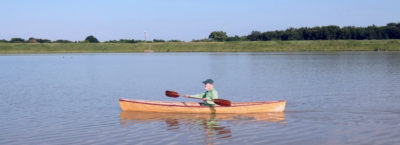
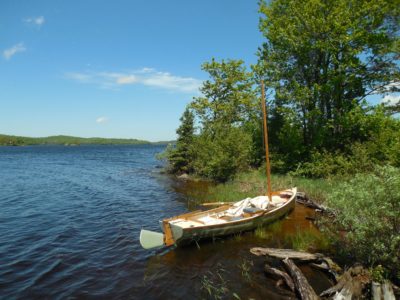
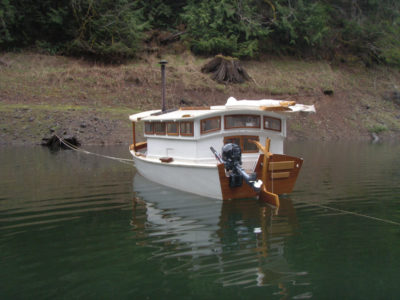
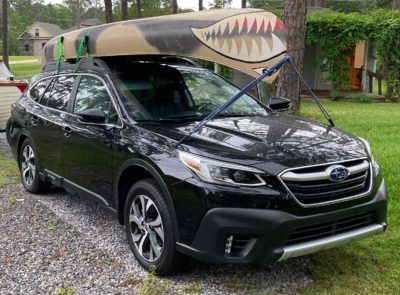

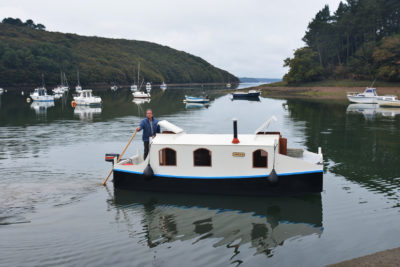
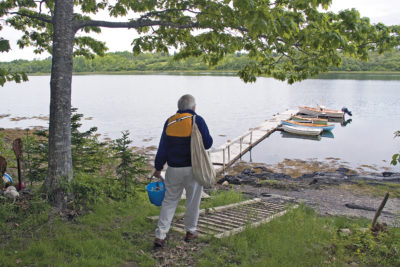
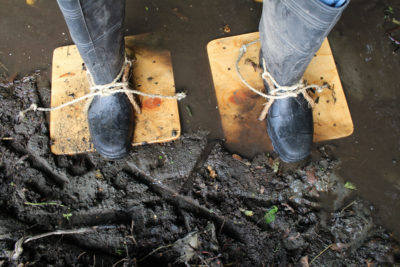
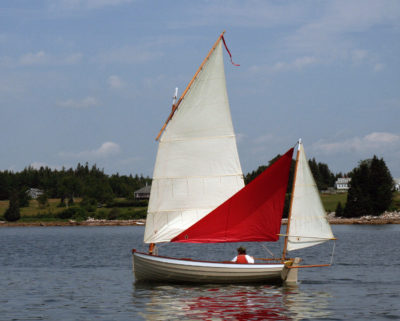
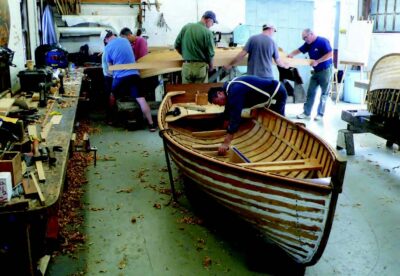
I would like information on the canal boat.
Rich
Hi Rich,
Please see the description of the boat at the end of my article “A San Juan Islands Solo.” There are no plans for the boat.
Thanks for your interest,
Chris